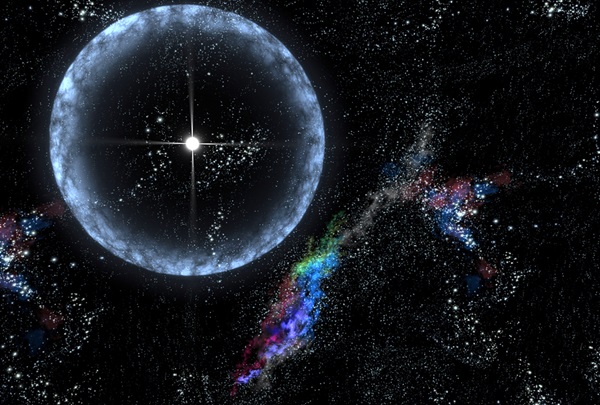Key Takeaways:
- Magnetars, neutron stars with extraordinarily powerful magnetic fields (1015 Gauss), are a recently discovered class of celestial objects, distinguished by their ability to generate immense energy bursts.
- These bursts, primarily gamma-ray flares, result from "starquakes" caused by the intense magnetic field deforming the magnetar's crust, leading to the creation and annihilation of matter-antimatter pairs.
- Unlike typical stars powered by nuclear fusion, magnetars derive their energy from the gradual decay of their powerful magnetic fields, a process that eventually weakens the starquakes and gamma-ray emissions.
- The December 27, 2004, flare from SGR 1806-20, located 50,000 light-years away, demonstrated the capacity of magnetars to impact Earth's ionosphere, highlighting their unique influence on our planet despite vast distances.
The nuclear furnaces in the Sun and stars create blistering heat and blinding light. Magnetism, however, plays no role in the fusion process that converts their mass to energy. Thus, a major magnetic field would seem like coleslaw at a picnic — nice but unnecessary, and certainly irrelevant in the energy big leagues.
At least that’s how it always appeared. Not any more. Recently, researchers have found that neutron stars, already among the all-time weirdest objects, can be wrapped in magnetic fields brawny enough to affect the rest of the universe.

Bringing the universe to your door. We’re excited to announce Astronomy magazine’s new Space and Beyond subscription box – a quarterly adventure, curated with an astronomy-themed collection in every box. Learn More >>.
The first hint of magnetic trouble arrived March 5, 1979, when a gamma-ray burst swept through the solar system at the speed of light. Radiation monitors aboard spacecraft near Venus and Earth suddenly went off scale. The deadly torrent lasted for only one-fifth second, but in that eye blink, some mysterious object had given off twice the energy our Sun had emitted since the building of the Pyramids! Scientists could not explain the burst by any known phenomenon. Eventually, the culprit was narrowed down to an invisible neutron star in a neighboring galaxy.
All that power from a tiny neutron star — a dead ex-sun that doesn’t even boast a nuclear generator? Maybe we needed to take another look at them.
All neutron stars are tiny. Each is about the length of South Carolina’s Hilton Head Island. They’re among the few suns with a solid surface — an indestructible, half-mile-thick crust floating atop a bizarre fluid of subatomic particles. This material is “hyper packed”; each apple seed-sized speck outweighs a loaded freight train.
A neutron star forms when a massive star collapses and sends supernova brilliance outward while its tiny remnant core implodes. That core — now a 12-mile-wide (20 kilometers) sun of its own — spins crazily, often hundreds of times a second. Such frenzied motion causes its magnetic field to wrap around itself, intensifying the field lines. What’s new about all this is an indication that during the youth of a neutron star, its magnetic field can reach the strength of a thousand trillion gauss. (Earth’s magnetism is less than 1 gauss.) Such stars are now logically called magnetars.
Astronomers have now discovered 23 confirmed magnetars, but only one, in Cassiopeia, is visible through optical telescopes. Astronomers detected the others solely by the types of radiation they emit. The nearest is a less than 9,000 light-years away, and more than a million other unknown magnetars are thought to loiter unseen in the dusty hallways of our Milky Way.
More bursts arrived since that first eye-opener. The biggest came on December 27, 2004. This magnetar emitted more energy in a tenth of a second than our Sun has released in 100,000 years! If it were located within 10 light-years of us, it would have obliterated our planet’s ozone layer and caused mass extinction.
The source, utterly invisible in visible light, lurks directly behind the center of our galaxy, on the opposite side of the Milky Way, some 50,000 light-years away. Its name is SGR 1806–20. This object in the constellation Sagittarius is the most magnetic object ever perceived.
Victoria Kaspi of McGill University in Montreal, Quebec, Canada, won the 2004 Herzberg Medal for her studies of these fantastic objects, and she remains obsessed with them. “Magnetars are the only deep-space objects to directly affect Earth,” she says. “The 2004 burst [from SGR 1806–20] changed our ionosphere from night to day. Some fishermen in the arctic saw a sudden aurora at that moment.”
And get this: Magnetars are not powered by nuclear energy. “In magnetars,” Kaspi explains, “we see a unique source of power. All of its energy comes from the gradual loss of its magnetic field.”
The intense magnetism bends and deforms a magnetar’s solid crust to produce “starquakes.” These are nothing like the tremors we get here, which can merely destroy a city. No, a neutron star’s ultra-dense starquakes release titanic bursts of energy that actually create electrons and antimatter positrons. When those combine and annihilate each other, they produce the lethal gamma rays that sweep through the universe.
Meanwhile, the magnetism slows the star. In a mere 10,000 years, according to current thinking, the magnetic field weakens to a paltry 2 trillion times greater than Earth’s. Then, the starquakes stop and the gamma rays die out.
In short, magnetars embody the physics of extremes: density, gravity, and magnetism. No wonder they’re so much fun.
Fun, that is, as long as we keep our distance. Imagine a future astronaut approaching SGR 1806–20. When half as far as the Earth-Moon distance, it would still look like a harmless dot, but all of the astronaut’s credit cards would suddenly be erased. He’s now broke, but curiosity still drives him forward. At 2,000 miles (3,000km), the magnetar still appears as just a pinpoint, but its magnetism now pulls every atom in the astronaut’s body into long, strange, needle formations.
The trip is over. It was a fatal attraction.










